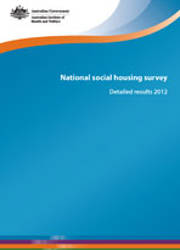Summary
The 2012 National Social Housing Survey (NSHS) is the most recent in a series of surveys of social housing tenants and their experiences. The 2012 NSHS sampled tenants of public housing (PH); state owned and managed Indigenous housing (SOMIH) and community housing (CH) programs. An overview of the national findings was published in May 2013 in National Social Housing Survey 2012: a summary of national results. This report provides national level analyses, state and territory comparisons and comparisons across programs.
How satisfied are tenants?
The majority of NSHS respondents indicated that overall they were satisfied with the services provided by their housing organisation.
- Tenant satisfaction with the services provided by their housing organisation was highest among tenants who had not been homeless in the past 5 years, lived in dwellings with no structural problems, or in dwellings that were not overcrowded.
- Community housing tenants were more satisfied with the services offered by their housing provider than public housing or SOMIH tenants.
What are the benefits of living in social housing?
Social housing tenants reported a range of benefits from living in social housing.
- The majority (more than 70%) felt more settled and are able to manage rent or money better.
- Around half benefitted by feeling more able to cope with life events and an improved sense of social inclusion.
What are dwelling conditions and use like?
- The majority of social housing respondents lived in a dwelling of an acceptable standard with 4 or more working facilities and no more than 2 major structural problems. This was most common for public housing, SOMIH and community housing tenants in Queensland, as well as community housing tenants in Western Australia.
- Only a small proportion of social housing dwellings were overcrowded, and this is considerably more prominent in SOMIH households.
- Underutilisation was more common than overcrowding in social housing dwellings. One in 4 SOMIH households were not fully utilised, as are 1 in 7 public housing and 1 in 10 community housing households.
Which support services are used most and by which tenants?
Tenants across all housing programs used health and medical services most frequently, followed by mental health services.
- Community housing tenants accessed community or health services most commonly.



